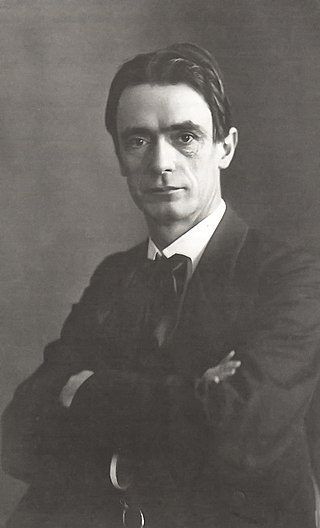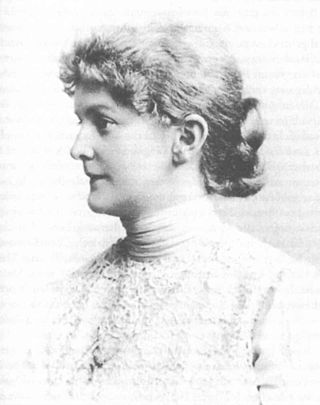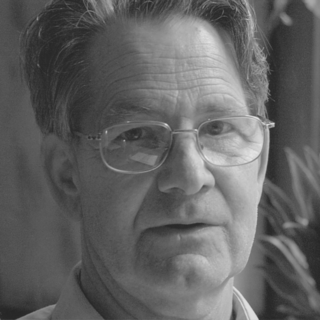Related Research Articles
Anthroposophy is a spiritual new religious movement which was founded in the early 20th century by the esotericist Rudolf Steiner that postulates the existence of an objective, intellectually comprehensible spiritual world, accessible to human experience. Followers of anthroposophy aim to engage in spiritual discovery through a mode of thought independent of sensory experience. Though proponents claim to present their ideas in a manner that is verifiable by rational discourse and say that they seek precision and clarity comparable to that obtained by scientists investigating the physical world, many of these ideas have been termed pseudoscientific by those outside the movement.

Rudolf Joseph Lorenz Steiner was an Austrian occultist, social reformer, architect, esotericist, and claimed clairvoyant. Steiner gained initial recognition at the end of the nineteenth century as a literary critic and published works including The Philosophy of Freedom. At the beginning of the twentieth century he founded an esoteric spiritual movement, anthroposophy, with roots in German idealist philosophy and theosophy. His teachings are influenced by Christian Gnosticism. Many of his ideas are pseudoscientific. He was also prone to pseudohistory.

Christian Otto Josef Wolfgang Morgenstern was a German writer and poet from Munich. Morgenstern married Margareta Gosebruch von Liechtenstern on 7 March 1910. He worked for a while as a journalist in Berlin, but spent much of his life traveling through Germany, Switzerland, and Italy, primarily in a vain attempt to recover his health. His travels, though they failed to restore him to health, allowed him to meet many of the foremost literary and philosophical figures of his time in central Europe.
The General Anthroposophical Society is an "association of people whose will it is to nurture the life of the soul, both in the individual and in human society, on the basis of a true knowledge of the spiritual world." As an organization, it is dedicated to supporting the community of those interested in the inner path of schooling known as anthroposophy, developed by Rudolf Steiner.

Marie Steiner-von Sivers was a Baltic German actress, the second wife of Rudolf Steiner and one of his closest colleagues. She made a great contribution to the development of anthroposophy, particularly in her work on the renewal of the performing arts, and the editing and publishing of Rudolf Steiner's literary estate.
Sergei Olegovich Prokofieff was a Russian anthroposophist. He was the grandson of the composer Sergei Prokofiev and his first wife Lina Prokofiev, and the son of Oleg Prokofiev and his first wife Sofia Korovina. Born in Moscow, he studied fine arts and painting at the Moscow School of Art. He encountered anthroposophy in his youth, and soon made the decision to devote his life to it.
The relationship between Rudolf Steiner and the Theosophical Society, co-founded in 1875 by H.P. Blavatsky with Henry Steel Olcott and others, was a complex and changing one. Rudolf Steiner founded the Anthroposophical Society on 28 December 1912, and he was expelled from the Theosophical Society on 7 March 1913.
Walther Cloos was a pharmacist, alchemist, Anthroposophist, lecturer, researcher, inventor, author and pioneer in anthroposophical pharmacy.
Hans Krüger was a pharmacist, anthroposophist, botanist, lecturer and researcher.
Wilhelm Pelikan was a German-Austrian chemist, anthroposophist, pharmacist, gardener and anthroposophical medicine practitioner.
Oskar Schmiedel was a pharmacist, anthroposophist, therapist, Goethean scientist and theosophist.

Weleda is a multinational company that produces both beauty products and naturopathic medicines. Both branches design their products based on anthroposophic principles, an alternative medicine.
Goethean science concerns the natural philosophy of German writer Johann Wolfgang von Goethe. Although primarily known as a literary figure, Goethe did research in morphology, anatomy, and optics. He also developed a phenomenological approach to natural history, an alternative to Enlightenment natural science, which is still debated today among scholars.
Wilhelm Rath was a German writer, translator, bio-dynamic farmer and anthroposophist. He is best known for his research and translations of certain medieval mystics, notably the Friend of God from the Oberland, Bernard Silvestris, Alanus ab Insulis and John of Hildesheim.
Herbert Hahn was a German teacher and Anthroposophist.
Violetta Elsa Plincke was a Waldorf teacher and lecturer on education who contributed much to the establishment of Steiner education in Britain.
George Adams Kaufmann, also George Adams and George von Kaufmann, was a British mathematician, translator and anthroposophist. He travelled widely, spoke several languages and translated many of Rudolf Steiner’s lectures into English. Through his studies in theoretical physics, he contributed to the expansion and development of the natural sciences as extended by the concepts of anthroposophy.
Rudolf Steiner wrote four plays that follow the initiation journeys of a group of fictional characters through a series of lives. These plays were intended to be modern mystery plays. Steiner outlined the plot of a fifth play to be set at the Castalian spring at Delphi, but due to the outbreak of First World War, this remained an unfulfilled project.

Wolfgang Schad was a German evolutionary biologist, anthroposophist and goetheanist.
Dankmar Bosse is a German geologist.
References
- ↑ Goethe on his scientific methodology: Der Versuch als Vermittler von Objekt und Subjekt
- ↑ Wolfgang Schad: Was ist Goetheanismus? On the History of the Word. In: Die Drei 5/2002, p. 36
- ↑ Wolfgang Schad: Was ist Goetheanismus? On the History of the Word. In: Die Drei 5/2002, II. Goetheanism in the Representations of Rudolf Steiner, Die Drei 6/2002, pp. 50-59
- ↑ Wolfgang Schad: Was ist Goetheanismus? On the History of the Word. In: The Three 5/2002, III. Goetheanism since Rudolf Steiner. In: Die Drei. Issue 7, 2002, pp. 54-65
- ↑ Wolfgang Schad: Was ist Goetheanismus? On the History of the Word. In: Die Drei 5/2002, and Andreas Suchantke: Goetheanism as the "Grounding" of Anthroposophy, Die Drei 2 and 3/2006
- ↑ Rudolf Steiner's lecture on 9 April 1923 in Basel, page 7 (PDF; 120 kB)
- ↑ Ernst-August Müller et al: Goetheanism. Elemente der Naturwissenschaft 33, p. 37f (1980), here in slightly revised form adopted with permission of the copyright holder
- ↑ Goethe about his scientific methods: Der Versuch als Vermittler von Objekt und Subjekt
- ↑ Jochen Bockemühl: Die Bildebewegungen der Pflanzen. In: Forms of appearance of the etheric. Stuttgart 1977, ISBN 3-7725-0401-9
- ↑ George Adams, Olive Whicher: The Plant in Space and Counterspace. Stuttgart 1960
- ↑ Rudolf Steiner: Das Verhältnis der verschiedenen naturwissenschaftlichen Gebiete zur Astronomie. GA-No. 323, 1926, ISBN 3-7274-3230-6
- ↑ Herrmann Poppelbaum: Tier-Wesenskunde. Dornach 1938
- ↑ Wolfgang Schad: Mammals and Man. Stuttgart 1971
- ↑ Rudolf Steiner: Of Soul Riddles. GA-No. 21, 1917
- ↑ Rudolf Steiner: The Key Points of the Social Question. GA No. 23, 1919, ISBN 3-7274-0230-X
- ↑ Aphorismen.de
- ↑ Letters of Goethe